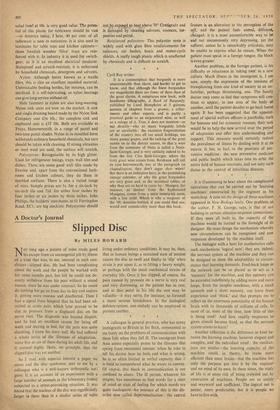Consuming Interest
Plastics in the Home
By LESLIE ADRIAN has largely eliminated the chore and dish-drying. This, with the polythene bowl and sink strainer, has, I have suddenly noticed, made washing up a noiseless process.
As their uses have increased, plastics have de- veloped and there are now at least ten different varieties, each with its own characteristic proper- ties. Which plastic is used for what job is, of course, a matter for the manufacturer, but, as their numbers increase, it is important that the public are able to identify them. Not all are the indestructible wonder materials some people think they are and certain chemicals in common use in the home can be ruinous to them. The Plastics Division of ICI have just brought out a timely ABC of Plastics which I think is worth passing on : Melamine: Much of the tough new plastic tableware is made of melamine. The best-known brand name is Melloware, and this is available at most big stores in pleasant bright colours. A cup and saucer cost 6s. 6d.; and the ten-inch salad bowl at 10s. is very good value. The poten- tial of this plastic for tableware should be vast —in America today, I hear, 40 per cent. of all tableware is now in melamine. It is also used in laminates for table tops and kitchen cabinets— those Swedish wooden 'Silva' trays are rein- forced with it. In industry it is used for switch- gear, as it is an excellent electrical insulator. Stainproof and scratch-resistant, it is unharmed by household chemicals, detergents and solvents.
Nylon: Although better known as a textile fibre, this is also an excellent moulded material. Unbreakable feeding bottles, for instance, can be sterilised. It is self-lubricating, so nylon bearings can give long service without oil.
Slide fasteners in nylon are also long-wearing. Nylon sink units are now on the market. A sink and single draining board made by the Nylon Sink Company cost £16 10s.; the complete sink and cupboard unit is £33 10s. Both are available at Froys, Hammersmith, in a range of pastel and two-tone pastel shades. Nylon in its moulded form withstands ordinary household chemicals, but care should be taken with cleaning. If strong abrasives or steel, wool are used, the surface will scratch.
Polystyrene: Recognisable by its high glitter. Used for refrigerator linings, trays, wall tiles and dishes. There are some good wall tiles made by Everine and, apart from the conventional bath- room and kitchen colours, they do them in marbled surfaces. There is also a varied range of sizes. Sample prices are Is. for a six-inch by six-inch tile and 7/d. for either four ,inches by four inches or six inches by three inches. John Phillips, the builders' merchants, at 61 Farringdon Road, ECI, are big stockists. Polystyrene should not be exposed. to heat above 70° Centigrade and is Samaied by cleaning solvents, essences, tur- pentine and petrol.
Reinforced polyesters: This polyester resin is widely used with glass fibre reinforcements for suitcases, car bodies, boats and motor-cycle shields. A really tough plastic which is unaffected by chemicals and is difficult to scratch.
Cyril Ray writes: It is a commonplace that burgundy is more unaccountable than claret, and harder to get to know, and that although the finest burgundies are magnificent there are fewer of them than of the great clarets. A sumptuous new book, with handsome lithographs, A Book of Burgundy, published by Lund Humphries at 3 guineas, consists of chapters from a grower, a cellar- master and other experts, and is partly a practical guide to an enigmatical wine, as well as a eulogy of it. True, it does not mention—or not directly—why so many burgundy labels are so unreliable : the excessive fragmentation of the country into all too small holdings, too many gamay grapes, and the tacking of the great names on to the district names, so that a wine from the commune of Nuits is called a Nuits- Saint-Georges, and is very unlikely indeed to be from the tiny Clos Saint-Georges, where the truly great wine comes from. Bordeaux will roll its eyes heavenwards, too, at the paragraph on chaptulization; they don't sugar their wines! But there is an indication here, in the painstaking vintage calendar, of why the great burgundies are very great and, in the statistical tables, of why they are so hard to come by: Musigny, for instance, as distinct from the hyphenated Musignys, comes from a mere twenty-six acres, with a low yield. Which is why a magnum of the '49, domaine-bottled, if you could find one, would cost considerably more than this book.



































 Previous page
Previous page